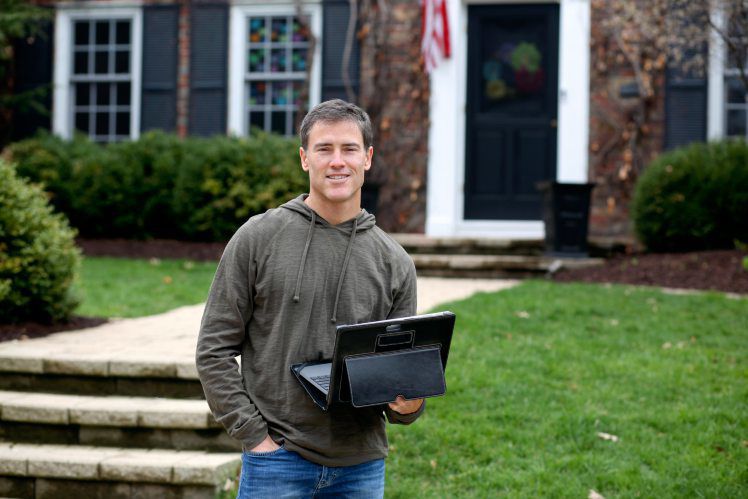A morning commute to work often requires time and patience. However, when COVID-19 hit, everything changed and many tri-state businesses quickly needed to transition staff to work from home. This involved overcoming communication, technology and productivity challenges.
In the U.S. prior to 2020, approximately 7% of employees worked from home, according to Pew Research Center. Typically, the option went to higher-salaried staff doing computer work for larger companies.
After the pandemic ends and workers return onsite, businesses will review the data and lessons learned. In the meantime, local executives responded to questions on their experiences of managing at-home employees.
Diann Guns, Vice President, Regional Human Resources Business Partner, Dubuque Bank and Trust
How many employees transitioned to at-home work and what challenges were faced?
All employees are working remotely, except for alternating teams that serve customers in branch drive-up windows. One challenge is learning new ways to do things, such as relying more on technology. Those without school-aged children might face isolation and loneliness, and those with school-aged children are trying to work while simultaneously providing (care). Another challenge is centered on keeping spirits up.
How have you adapted methods for communicating and accomplishing priorities? We continue to rely heavily on email, but we are using other technologies more like video calling. We encourage managers and staff to use this technology to feel more connected. In our industry, administering government programs, such as the Payroll Protection Program, and finding other ways to help alleviate the financial concerns of our customers take a great deal of time and effort. Helping our customers and employees guides our priorities.
What suggestions do you have for other businesses? Our organization began offering training, and all managers are participating. It offers tips on how to handle communications, set clear expectations for performance, while avoiding the temptation to micromanage. Communicating frequently is important as well as being specific about what should be done and trusting employees to show results.
How do you address morale? We have a dedicated site for employees to see all pertinent updates and communications related to our COVID-19 response, but it also has another purpose. Employees are encouraged to submit pictures and stories about how they are keeping up morale and having fun. Some departments are setting up virtual social hours, lunches, etc. — we are seeing many funny and inspiring stories submitted.
What will you take back when employees return onsite? We have made decisions in a day or two that normally would take weeks. We are learning the benefits of a nimble response. I have been so impressed with how generous our leadership has been and how concerned about the welfare of our staff. We are going to be a closer, better team. We have learned that flexible work arrangements and virtual communications are perfectly acceptable in situations we avoided before.
Andrew J. Butler, Executive Chairman, Cottingham & Butler
How many employees transitioned to at-home work and what challenges were faced? We have successfully transitioned more than 97% of our team, with those at the office providing essential services. We did have a number of people working from home prior, so we had a good understanding of the needs. The biggest challenges we faced (were) making sure technology connections worked properly and that the team was trained.
How have you adapted methods for communicating and accomplishing priorities? Efforts focus on Zoom meetings, phone calls and video messaging. There is a great deal of frightening news from health and job standpoints. It is important that we are transparent and timely in sharing. Our leadership team meets to discuss priorities, progress, accomplishments and special projects. Our team is doing a remarkable job in serving our customers and acting on ideas to take the initiative.
What suggestions do you have for other businesses? Our leadership team is reaching out to people simply to check in. I spend between two to four hours a day talking with our team, clients and friends in the industry. As difficult as the COVID-19 pandemic has been, it is refocusing us on the importance of personal relationships in our lives.
How do you address morale? We have a great team sensitive to the needs of their colleagues. In addition to regular departmental Zoom sessions, we have seen in after-hour sessions people showing off their pets and kids and even vigorous fitness challenges. Our group is finding ways to build better bridges with their teams and colleagues from a distance.
What will you take back when employees return onsite? The human spirit overcomes all. I am so impressed with how our team has worked together to focus on the things that are truly important. This experience has served to reinforce the need to focus on what I will call empathetic communication. We need to create an experience for people with whom we connect remotely that is on par with a personal experience.
Chad Chandlee, President and Chief Operating Officer, Kendall Hunt Publishing
How many employees transitioned to at-home work and what challenges were faced? The company is at 99%. My assistant and I have worked out a system where if I need to sign things, I come in after hours or when she isn’t there. Challenges are related to not having the same access to technology. People also are struggling with how to deal with both (spouses) working from home, especially difficult if (they) have young kids. We are making sure our employees understand that we understand.
How have you adapted methods for communicating and accomplishing priorities? We implemented Microsoft teams, (for) video calls with teams. I try to send communication at least once a week with all our employees, assuring them that our company is doing well financially and thanking them for working hard. Each manager is in charge of creating a solution that works for their team. In this new environment, I wanted to steer clear of the one-size-fits all mentality.
What suggestions do you have for other businesses? Give people your trust in getting things completed. Our managers are staying in close contact with their teams and making sure we are sensitive to what is happening in their lives, but also staying on top of things before they get too far out of line. If we need to adjust, we do it quickly.
How do you address morale? People are sharing positive stories about work as well as funny things that are happening in their lives. Again, I try to communicate at least weekly letting them know that what we do is important and that they are doing a great job.
What will you take back when employees return onsite? Most people I have spoken with thought they would have more down time and have found themselves as busy or busier than normal. People are more efficient than they thought they would be, but they are also seeing team members more often through video. It appears that people are doing an even better job of communicating showing how effective we can be without traveling to see vendors or customers.
Stefanie Rupert, President and CEO, Collins Community Credit Union
How many employees transitioned to at-home work and what challenges were faced? We had only a handful of permanent (or occasional) remote workers. When the virus hit, we mobilized 62% of employees to work from home. Most office staff are those that serve the membership directly. We have surprisingly done well with teams working in the office and working remotely; however, we are running out of creative ideas to keep them all happy and connected. We (recently) ran a spirit week and office surroundings contest and published the unique fashions and decorations.
How have you adapted methods for communicating and accomplishing priorities? We added another weekly call enterprise wide. I kick off with a 15-minute update and occasionally toss it to a relevant group to cover other interesting topics. I send out a daily newsletter with announcements, product/project advancements and shout-outs.
Whenever possible, we use our internal project manager to organize projects. We mandated an agenda at every meeting. The prioritization of products is frequent since we do strategic planning all year long. We have abandoned projects that do not connect our membership to technological solutions.
What suggestions do you have for other businesses? Our cloud solutions provide us data on productivity as do our various scorecards that keep our employees focused on the right path. Frequent, planned check-ins with staff keeps everyone connected.
How do you address morale? Spirit week was loads of fun. (Staff) posted some of their stuff on their Facebook pages. We joke a lot. I reference “corny Iowa” jokes on our all employee calls. I play loud, fun music to get people moving. The latest is a workspace contest. We have many animals and kids photobombing … and Zoom background changes. Places they have been, want to go, match their outfits.
We have worked on developing a work hard, play hard culture, so the employees have not disappointed. I would say the employee stamina has surprised me. I don’t think we can do this forever, but they are putting forth every ounce of their being to see it through with grace, humor and professionalism.
What will you take back when employees return onsite? Every one of these scenarios will be different, but the playbook is built. Have supplies on hand. Shelf the programs for easy deployment. Continue to do table-top exercises to keep the muscle memory fresh for swift action. Don’t go back to the way things were; make some bold changes that make sense for the business.






